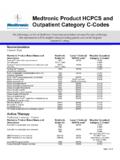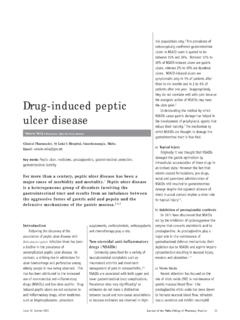Transcription of NEW ZEALAND DATA SHEET - Medsafe Home Page
1 Version 1 NEW ZEALAND data SHEET 1. PRODUCT NAME DBL Pethidine Hydrochloride Injection BP 50mg/ml 2. QUALITATIVE AND QUANTITATIVE COMPOSITION DBL Pethidine Hydrochloride Injection BP is available as a 50 mg/1 mL, 75 mL, and 100 mg/2 mL solution. DBL Pethidine Hydrochloride Injection BP is a sterile, clear solution of Pethidine Hydrochloride BP and sodium hydroxide in Water for Injections BP. The pH of the injection ranges between and DBL Pethidine Hydrochloride Injection BP is available as a sterile, isotonic 50 mg/10 mL solution. This injection contains 79 mg sodium chloride in order to render the solution isotonic. The pH of the injection ranges between and For the full list of excipients, see section 3. PHARMACEUTICAL FORM Solution for injection. Pethidine Hydrochloride is a white crystalline powder, very soluble in water and freely soluble in alcohol.
2 4. CLINICAL PARTICULARS Therapeutic indications Pethidine is indicated for short-term (24-36 hours) relief of moderate to severe pain. It can be given via the following routes of administration intramuscular, subcutaneous, slow intravenous bolus injection, intravenous infusion and patient controlled analgesia (PCA). Pethidine is indicated for administration as an anaesthetic adjunct and for obstetric analgesia. Dose and method of administration Dosage and Administration Pethidine is indicated for short-term (24-36 hours) relief of moderate to severe pain. It can be given via the following routes of administration intramuscular, subcutaneous, slow intravenous bolus injection, intravenous infusion and patient controlled analgesia (PCA). An opioid antagonist and facilities for administration of oxygen and control of respiration should be immediately available during and immediately following intravenous administration of pethidine.
3 Dose Adult Dosage 1. Analgesia Dosage should be adjusted according to the severity of pain and the response of the patient and also depends on patient profile eg: age, weight, sex, previous exposure to narcotics. 25 to 100 mg by IM (preferred) or injection, every 3 to 4 hours. 25 to 50 mg slow IV injection, every 3 to 4 hours (see section ). Version 2 Usual dose is 200 mg/day by the IV route. Intravenous injection should be made very slowly, preferably using a diluted solution. For continuous intravenous infusion adequate analgesia should be established prior to commencement of the infusion . A dosage of mg/kg/hr is recommended as the initial intravenous infusion rate. Clinical experience suggests that patients with normal renal function receiving more than 1000 mg/24hrs pethidine are at particular risk of developing pethidine associated neurotoxicity (PAN).
4 Patients receiving over 800 mg/24hrs pethidine should usually be monitored for early signs of norpethidine toxicity (see section ). 2. Obstetric Analgesia 50 to 100 mg by IM (preferred) or injection, administered when pain becomes regular. May be repeated 3 to 4 times at one to three hour intervals if necessary. Note: Maximum of 4 doses in 24 hours 3. Anaesthesia Adjunct As premedication, intramuscular (preferred) or subcutaneous, 50 to 100 mg thirty to ninety minutes prior to anaesthesia. As an adjunct to anaesthesia, intravenous, by repeated slow injection of fractional doses of a solution diluted to 10 mg per mL. See section prior to administering by the IV route. Dosage by this route should not exceed 25 to 50 mg. Note: Dosage must be titrated to the needs of the patient, depending on the premedication given, the type of anaesthesia, and the nature and duration of the surgical procedure.
5 4. Patient-Controlled Analgesia Patient-controlled analgesia (PCA) allows patients to assess their own level of pain and consequently titrate the amount of pethidine they require for adequate pain control against sedation and other side effects. Adequate analgesia should be established prior to commencement of PCA. The dosages and time intervals are preset into a microprocessor-controlled infusion pump. When the patient experiences pain, a button is depressed by the patient and a dose of pethidine is administered intravenously. If the patient should depress the button before the preset time interval (lockout interval) has elapsed, no extra drug is administered. For adults, demand doses, of 5 mg to a maximum of 20 mg pethidine have been given via PCA using a lockout interval of 6 to 20 minutes.
6 Along with the self-administered dose of pethidine, some syringe pumps also deliver a background continuous infusion of pethidine at a basal rate. Some PCA pumps allow a maximum dosage over a defined period to be preset in order to avoid patient overdosage. The demand dosage and lockout interval should be determined according to the patient s analgesic requirements. Patients receiving a background infusion of pethidine should generally receive a smaller demand dose relative to equivalent patients utilising a demand dose only. Clinical experience suggests that patients with normal renal function receiving more than 1000 mg/24hrs pethidine are at particular risk of developing pethidine associated neurotoxicity (PAN). Patients receiving over 800 mg/24hrs pethidine should usually be monitored for early signs of norpethidine toxicity (see section ).
7 Note: Pethidine-associated neurotoxicity is dose related, so pethidine should not be used for periods greater than 24 to 36 hours, see section Paediatric Dose 1. Children Analgesia Intramuscular (preferred) or subcutaneous, to 2 mg per kg of body weight, not to exceed 100 mg, every three to four hours as needed. Version 3 Preoperative - Intramuscular (preferred) or subcutaneous, 1 to 2 mg per kg of body weight, not to exceed 100 mg, thirty to ninety minutes prior to anaesthesia. 2. Neonates (see also section and ) Excretion and metabolism of pethidine in the neonate is reduced compared with adults. Safety has not been established in neonates and due to lack of data , no dosage regimen can be recommended. Geriatric patients Dose reduction to half normal adult dose is recommended in geriatric patients (over 70 years). Liver impairment Dosage reduction and/or increased dosage intervals are recommended.
8 Renal impairment Due to the possibility of accumulation of norpethidine in patients with renal failure, caution should be exercised when pethidine is administered to these patients, especially over prolonged periods of time. Therefore, a decrease in the dose or increase in the dosing interval is recommended (see also section ). Dose conversion Pethidine, when given intramuscularly in a dose of 75 to 100 mg is equivalent in analgesic effect to the following: Codeine Phosphate 120 mg Fentanyl Citrate 200 micrograms Morphine 10 mg Methadone Hydrochloride 8 to 10 mg Contraindications Hypersensitivity to Pethidine. Respiratory depression, or where respiratory reserve is depleted (acute bronchial asthma, chronic airway disease, severe emphysema, severe chronic bronchitis, kyphoscoliosis). Head injury, raised intracranial pressure (apart form introducing monitoring and diagnostic problems, hypercapnia associated with respiratory depression can itself result in elevated intracranial pressure), brain tumour.
9 Cardiac arrythmias, especially supraventricular tachycardias, cor pulmonale. Pethidine has a vagolytic action and may produce a significant increase in the ventricular response rate. Concurrent use of monoamine oxidase inhibitors (MAOI s), including selegeline, or use of MAOI s within two weeks prior. The combination of monoamine oxidase inhibitors and pethidine has caused hypotension, hypertension, excitation, rigidity, hyperpyrexia and/or convulsions and in some cases fatalities have been reported. This combination should be avoided. Pre-eclampsia, eclampsia. Convulsive states such as status epilepticus, tetanus and strychnine poisoning, due to the stimulatory effects of pethidine on the spinal cord. Diabetic acidosis where there is a danger of coma. Acute alcoholism or delirium tremens. Severe liver disease, incipient hepatic encephalopathy. Patients with a low platelet count, coagulation disorders or receiving anticoagulant treatment.
10 Version 4 Continuous Intravenous infusion : The administration of pethidine via continuous intravenous infusion in patients with renal impairment is contraindicated. Patient-Controlled Analgesia: The administration of pethidine via patient-controlled analgesia (PCA) in young children and adults with poor cognitive function is contraindicated. The administration of pethidine via PCA in patients with renal impairment is contraindicated. Special warnings and precautions for use Therapy should only be initiated by a specialist with experience in chronic pain management and in accordance with guidelines approved by the New ZEALAND Medical Council. Large doses and/or rapid intravenous administration of pethidine may produce rapid onset respiratory depression, apnoea, hypotension, peripheral circulatory collapse, bradycardia (as a result of stimulation of medullary vagal nuclei) or even cardiac arrest.
















